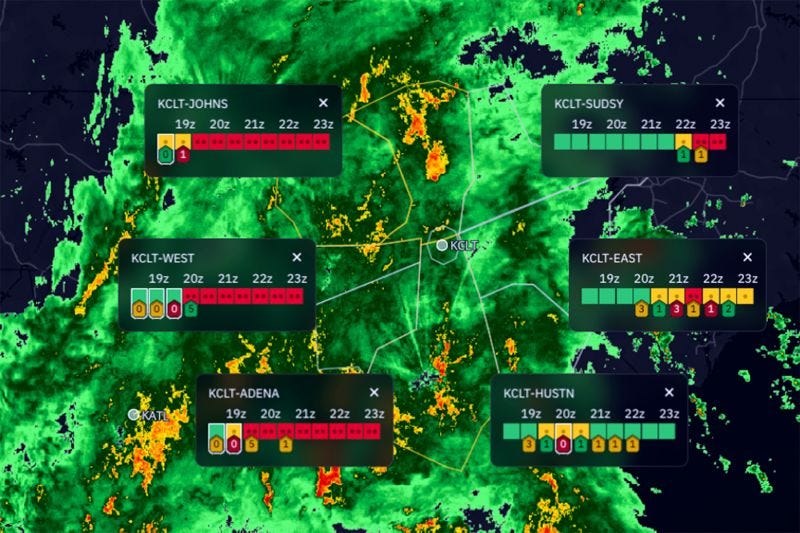Welcome to our second collection of briefs from last week’s annual meeting of the American Meteorological Society. That meeting is the big one for our field. However, the AMS also hosts many more focused meetings across the year. This includes such fun names as the“36th Conference on Agricultural and Forest Meteorology, 18th Conference on Polar Meteorology and Oceanography, 15th Fire and Forest Meteorology Symposium, and Seventh Conference on Biogeosciences” - all of which are melted down into a single meeting lasting 5 days in May.
I hope to attend some of these meetings in the years to come to bring you the hottest news from the world of meteorology/oceanography/biogeosciences that TMZ refuses to cover!1
Tornados, Schools, and Parental Decisionmaking
Ask a kid if we should have a school weather day and 99% of them will fully approve.
(The 1%)
OTOH, ask a parent and I would have predicted 99% would disapprove.
And I would be wrong. Way wrong.
Steve Wootten from Mississippi State University presented a poster describing a study of parental preferences for handling severe weather days. Surveys were sent to 500 parents/guardians of school-age children living in tornado-prone states. Parents were asked about their dismissal preferences in the wake of tornado threats, and a regression analysis was run to look for variables related to those preferences.
When it comes to tornado watches, parents were evenly split between wanting their children to remain at school or be sent home. However, when a school decides to close due to an enhanced tornadic threat2, most parents (74%) want their children sent home. This was regardless of the time of day.
Their decisions were related to many variables, including trust in school officials (and knowledge of their shelter-in-place plans), the potential severity of the storms, and the type of building structure they lived in. Results suggest the importance of educating parents about school procedures during severe storms as it could help them make important decisions when the time comes.
Probability of Warming Shelters
When it comes to snow, my favorite forecasting product is the NWS Probabilistic Snowfall Experiment. It provides a quick glance at the odds for snowfall at a given place/time. I find it a super easy and accurate source to decide whether I’m staying home or going to the [gym, bank, dentist, probation officer meeting, etc.] that morning.
Fred W. McMullen (National Weather Service) presented a poster describing a similar product to visualize the odds of especially cold nights around Pittsburgh.

The goal is to supply the Allegheny County Health Department with a quick way to predict the need for additional beds and other resources to support unhoused populations. These events, called Code Blue Days, generally occur when nighttime temperatures drop below 26 degrees Fahrenheit. Happily, this was a temporary need. Last year, ACHD was able to eliminate Code Blue alerts by increasing shelter capacity to more than 600 units on a nightly basis.
This was a terrific example of a useful, custom-designed product that addressed a critical need, was rapidly deployed when required, and ultimately resulted in an even better, permanent solution. Government bureaucracy doesn’t always work this way. But when it does, it’s powerful.
Predicting Weather-related Flight Delays
The aviation industry and meteorology are both fond of acronyms. The Airport Acceptance Rate (AAR) and Airport Departure Rate (ADR) are two acronyms that describe the number of aircraft that can land and depart at a particular airport per hour.
John K. Williams from The Weather Company led a research team that used a neural network to assess their Forecast on Demand (FoD) product's impact on AAR and ADR. The FoD is a product for customized and up-to-date weather forecasts at any time, essentially generating a new forecast specifically for the moment it is requested rather than relying on pre-set updates. Its aviation applications use dozens of variables such as ceiling, cloud cover, humidity (gah!), wind speed, and more.

The model was trained on data from 99 North American airports from August 2022 - December 2023 and then tested against data from all of 2024. They found predictions on ADR were generally better than those on AAR. This is likely due to the weather that aircraft encounter in flight being less predictable than the weather they encounter sitting on the ground. Although not explicitly stated, it's implied that adding more weather data that is not related to single-point observations, along with non-weather data such as airport runway configurations, could improve AAR. Of course, that’s a challenge schematically. But they have plans to do just that in their future work.
Next week, we’ll be back to our regularly scheduled deep dives into newly published research about meteorological impacts on octopus arm wrestling (you’d be surprised).
And Now for Something Completely Different
SNL is celebrating its 50th season next month. Below is a young John Belushi describing the cultural differences in March weather proverbs. It’s funny on the surface, but deep down, it makes some sense as an illustration of seasonal differences across the globe.
The modern saying goes back to 1732 (at least). Some think it has to do with the constellations (Leo the Lion is high in the northern sky in early March evenings, while Aries the lamb is high in late March). However, the other proverbs mostly focus on weather. They include this gem, which would look great on a bumper sticker:
March many-Weathers rain’d and blow’d / But March grass never did good.
Surely, that would get people off your tail as they pontificate your clearly superior wit.
This wasn’t defined, but a tornado warning should have the kids taking shelter immediately, so it wasn’t that. I’m thinking something like a forecast for a significant tornado outbreak that gained enough traction in the media to create alarm.







Errata: In the original (e-mailed) version of this article I mis-ID'd James Belushi as Jim! I have fixed it in the archived version.
These are definitely important tools and resources. I pray we still have access them in the months to come.